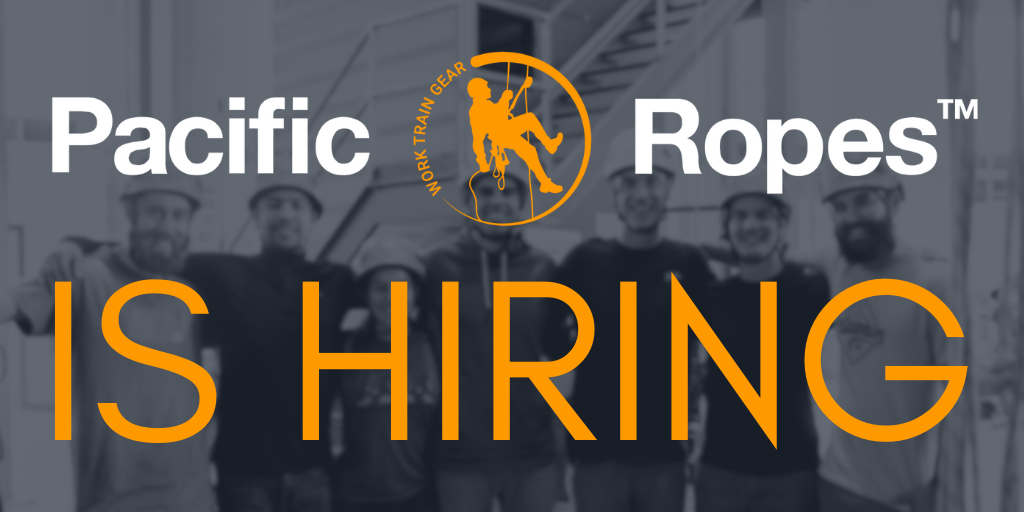Photo provided by Brent Hannam.
The article was co-written by Terrah Jong (Marketing and Business Development Strategist @ Pacific Ropes and Andrea de Vries Communications Coordinator @ Raven Rescue).
From caving and mountaineering to Rope Access and Technical Rope Rescue, specific safety regulations, techniques, systems, gear and tools are accredited to each practice individually. For the seasoned practitioner, knowing which rope practice to turn to for a particular outcome may feel like common knowledge. However, an exceeding amount of crossover actually exists between each rope field and their adjunct rope systems (just take a look at WorkSafe BC’s Regulation Part 34 to see how caving/mountaineering practices initially influenced the method of Rope Access).
Despite these disciplinary connections, certain tensions can arise when addressing Rope Rescue methodologies. There are many similarities between Rope Access and Technical Rope Rescue (TRR) approaches, yet their specific differences can lead to an ‘Us vs. Them’ opposition when assigning a value or preference for one or the other. The inclination to assert loyalty to a single method instead of unravelling the ways in which these schools can work together is not only harmful to the industry of rope work writ large, but most importantly, can inhibit safety advancements meant to protect the people who work within these fields.
Safety, after all, is the heart of rope rescue within these industries.
There is no question that nuances exist between Rope Access and TRR. Bringing together experts in these fields will create a framework for thinking about collaboration and movement within the future of our industry. This piece of writing hopes to address the beginnings of this future, and provide you with a piece of reading that explores the relationship between Rope Access and TRR with a rootedness in best practice, teamwork, and safety as it currently stands.
Pacific Ropes (www.pacificropes.com) and Raven Rescue (www.ravenrescue.com) have come together to explore the crossover between these two distinct rope fields – Technical Rope Rescue and Rope Access. As experts in each of their respective fields, they have offered to provide their insight to highlight their industry’s differences and similarities, all the while touching on the potential innovations that crossover can bring.
 Raven Rescue TRR Rescue Training
Raven Rescue TRR Rescue Training
 Pacific Ropes Rope Access Rescue Training
Pacific Ropes Rope Access Rescue Training
Meet Ron Morrison, Raven Rescue’s Program Director
Meet Tim Zagiel, Pacific Ropes Ltd.’s Founder/Managing Director: Tim brings over 18 years of experience in business from multiple industries including marketing, business and Rope Access. Inspired to find ways to instill professionalism, safety and training into the Rope Access industry, Tim founded Pacific Ropes in 2008. Tim directs all Pacific Ropes Rope Access Contracting projects in Vancouver and throughout the Province of BC.
Contributors: Don Gibbons (IRATA L3, SPRAT L3, Trainer at Pacific Ropes) and Andrew Munoz (SPRAT L3, NFPA 1006 Rescue Tech and Primary Care Paramedic).
Question and Answer Period - take it away guys!
Q: What are some key similarities between Rope Access Rescue and Technical Rope Rescue technical practices? (i.e. gear, methodology, etc):
Ron: Both Rope Access and Technical Rope Rescue rely on good pre-planning and management, risk assessments, and competent, fit personnel. System and component redundancy, as well as carefully selected specialized equipment can be found in both fields. You’ll also encounter training schemes divided into various levels, and safe work procedures, or standard operating procedures.
Tim: There are similarities in equipment, procedures, and methods.
Ropes, connectors, hardware can be suitable for both. Both have an understanding of tensioned systems/angle loading, mechanical advantages gained through complex pulley systems, different methods of protecting the rope, similar knots, hauling, lowering, ascending, descending, high lines/tension lines, pick off rescues, and more.
Similar in both are the training requirement and form of "level" system. NFPA 1006 outlines an individual’s skills and competency between Level I and Level II. In the rope access world, these are simply Level 1, Level 2, and Level 3.
Both have the same Objective (heights, forces) and Subjective hazards (weather, industrial processes), and are trained in hazard assessment and rescue planning.
Lastly, they sadly both share a “reactionary” trend to only change the standard after a fatal/near-fatal incident. There is considerable “moth-balling” of the skills (more so with the NFPA) when there have been no “problem” incidents. There is a lack of “data-driven” change in these organizations, and both sides need to focus on practical research to compile more static datum with which to judge “best-practice”.
Q: What are some key differences between Rope Access Rescue and Technical Rope Rescue practices?
Ron: When carrying out a rescue, fire personnel have access to more resources. They engage the rescue in a team-based approach, with an emphasis on an objective-based risk assessment – the adage “Risk a lot to save a lot, risk little to save little, risk nothing to save nothing” influences the rescue method ultimately used. Technical Rope Rescue usually employs a top down approach to the rescue, but climbing is increasingly common. Technical Rope Rescue also deals with building anchors and environments that are not pre-planned – there’s diversity to response zones, so Technical Rope Rescue methods are universal in their approach. Finally, Technical Rope Rescue can move between low angle (15-29 degrees), steep angle (30-50 degrees), and high angle terrain (over 50 degrees) in a single rescue.
Tim: For entry-level rope access technicians, the skill set starts at basic access skills and one simple co-worker pick off rescue. It's not until later in training upgrades that technicians get into more advanced rescue skills.
Andrew: Gear is major difference – to a layperson in all looks the same. But for a rescuer, different governing standards make different gear selections unavailable. This has occurred to the point that some gear which performs a nearly identical technical function would be inoperable by a person crossing fields, due to the design differences necessary to conform to the applicable standards.
NFPA gear is heavier, that’s a sad fact. Manufactures are beginning to carry the NFPA 1983 stamp more often now but as it stands, Rope Access gear is lighter, easier to use and cheaper too. The difference here is the “stress inoculation” factor. NFPA rescuers focus much more on the Incident Command System (ICS), decision making and ethics than the rope access community does.
A second difference is competency of skills at different levels of training. I do whole-heartedly agree that Rope Access Technicians have a higher proficiency generally (partly as a result of their training {Read: one/two person rescues}) but that only holds up at the higher levels.
Let’s put it this way: an IRATA 3 needs 2000hrs (and 3 exams) to get there and an NFPA 1006 Level II Rope Tech only needs ~64-80 hrs (no formal number attributed to this) to reach the same “top-level” in their field. There’s no question that the IRATA 3 will have better “rope-hands” in a random sampling. However the IRATA 1 vs the NFPA 1006 Level I level guys will have a reversed relationship. The IRATA 1 has very few skills out of their first exam (and even less exposure to the higher skills) whereas the 1006 Level I level guy will been a part of more complex rescues (although for a limited time) and therefore will have a better holistic rescue awareness.
Q: What relevant governing bodies/standards do Access Rescue and TRR both answer to?
Ron: Work at height regulations, both federal and provincial, apply to both fields. ANSI, ISO, EN, CI, NFPA, ASTM, and UL are other standards that apply to both fields.
Tim/Andrew: Access in Canada: IRATA, SPRAT, ISO 22846-2. Alberta OHS Regulations also allow ARAA (Australian) ticketed technicians to operate in the industry with their certification.
Access globally: IRATA, SPRAT, SOFT, FISAT, ECRA, ARAA, IRANZ, ANETVA, SFETH, and more
NFPA 1670: Operations and Training for Technical Search and Rescue Incidents (Awareness, Operations and Technician)
NFPA 1006: Rescue Technician Professional Qualifications (Level I and Level II)
NFPA 1983: Life Safety Rope and Equipment for Emergency Services
 Pacific Ropes Rope Access Rescue Training
Pacific Ropes Rope Access Rescue Training
Q: What governing bodies/standards are unique to Access Rescue and TRR, and what purpose do these unique standards serve?
Ron:
NFPA 1006 directs technicians’ attention to the specific JPRs for Rope Rescue Technicians.
NFPA 1670 applies to the level of functional capability for a responding service.
Rescue 3 International is the other leading industry standard for Technical Rope Rescue.
Rope Access Rescue turns to SPRAT/IRATA to spell out the contents of SOGs for Rope Rescue.
Tim: Nothing to add here that Ron and Question 3 didn’t answer.
Q: Describe the ideal candidate for Rope Access Rescue training, and the ideal candidate for TRR training - what kind of work are they doing, and why will choosing one or the other approach serve them well?
Ron: In Rope Access, the primary task is work. Rescue is secondary. From inspection, testing, and repair, to cleaning, painting and geotechnical work, as IRATA states on their employment page, “rope access is only a means of work positioning” and the industry has matured to the place where employers now expect technicians to have a profession or trade in addition to rope access. If you have a trade and need to access a unique place to do that work, Rope Access will meet your need. In Technical Rope Rescue, the primary responsibility is rescue. Members of fire departments, search and rescue teams, and industrial rescue personnel are all ideal candidates for Technical Rope Rescue training.
Andrew: If someone has a welding, pipefitting or electricians background and is looking to find value-added training, the synergy of these skills with a rope access ticket is huge. TRR training is great for senior rope access people to gain better supervisory skills and to gain better critical emergency scene management, and focus more on patient care. Also, TRR is an obvious choice for the volunteer firefighter looking to expand their resume to make a better candidate for a career fire jobs.
By combining the best of these two schools of thought, we are able to leverage collaboration and make curriculum developments which will ensure best practice in ALL rescue schools and scenarios. We can train a more disciplined, skilled, and critically thinking rescuer, armed with the latest information, gear and techniques. Rather than sitting in opposition to one another, we must remember: on every rope is a human life and our ability to protect that life is paramount whether in TRR or Rope Access. Any inability to work together could put this priority at risk. At the end of the day, working together is more innovative than remaining separate in our industries and the end result can bring about new concepts of rescue that make our jobs easier, more efficient, and perhaps even less stressful in the event of an emergency.
Moving forward, we encourage all of our rescue communities to think about what collaboration looks like for you. Where do you see the challenges, and most importantly, where do you identify the possible successes of working together? Challenges and opportunities are equally important to consider as we move forward as a rescue community.
Thank you for taking the time to read this and please share this with anyone you may know who has an interest in rope rescue in any industry. We welcome your feedback!
From all of us at Pacific Ropes and Raven Rescue,
Be safe and we’ll see you on the ropes!

Stay in touch with all things Rope Access and Pacific Ropes by Subscribing to our monthly newsletter!



